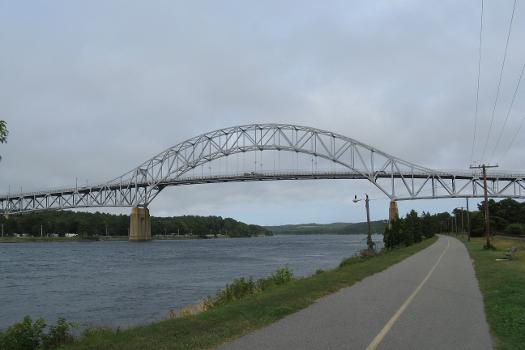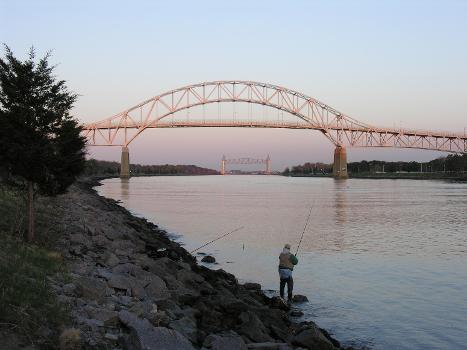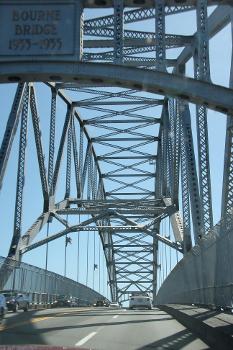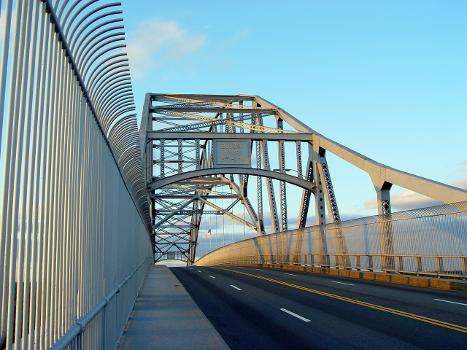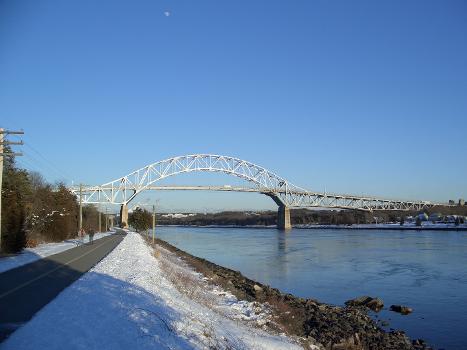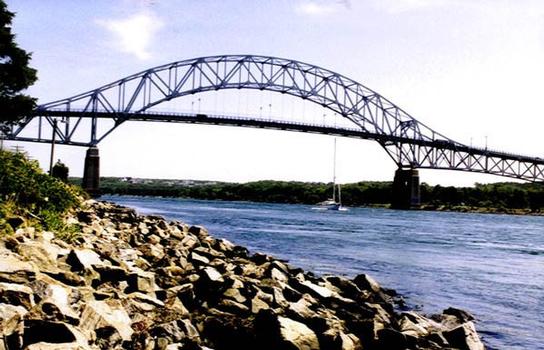General Information
Project Type
| Structure: |
Through arch bridge |
|---|---|
| Function / usage: |
Road bridge |
| Material: |
Steel bridge |
| Structure: |
Truss arch bridge |
| Support conditions: |
for registered users |
| Material: |
Structurae Plus/Pro - Subscribe Now! |
Awards and Distinctions
| 1934 |
First Place
for registered users |
|---|
Location
| Location: |
Bourne, Barnstable County, Massachusetts, USA |
|---|---|
| Crosses: |
|
| See also: |
Sagamore Bridge (1935)
|
| Coordinates: | 41° 44' 51.68" N 70° 35' 22.55" W |
Technical Information
Dimensions
| main span | 187.76 m | |
| span lengths | 120.7 m - 187.76 m - 120.7 m | |
| number of spans | 3 | |
| deck | number of lanes | 4 |
| roadway / carriageway width | 12.2 m |
Cost
| cost of construction | United States dollar 1 610 000 |
Materials
| piers |
reinforced concrete
|
|---|---|
| truss |
steel
|
Chronology
| 22 June 1935 | Dedicated and opened to traffic. |
|---|---|
| 22 June 1935 | Opened to traffic. |
Excerpt from Wikipedia
The Bourne Bridge in Bourne, Massachusetts carries Route 28 across the Cape Cod Canal, connecting Cape Cod with the rest of Massachusetts. It won the American Institute of Steel Construction's Class "A" Award of Merit as the "Most Beautiful Steel Bridge" in 1934. Most traffic approaching from the west follows Massachusetts Route 25 which ends at the interchange with US 6 and Route 28 just north of the bridge. The highway provides freeway connections from Interstate 495 and Interstate 195.
There is a six-foot wide sidewalk for pedestrian and bicycle access on the west side of the bridge. The sidewalk is slightly raised, but there is no fence or barrier between it and car traffic, and cyclists are recommended to walk their bicycle. The bridge road is plowed in winter, although the sidewalk is sometimes unplowed and unpassable. Bridges to the Cape are sometimes closed for safety during high winds.
History
The bridge and its sibling the Sagamore Bridge were constructed beginning in 1933 by the Public Works Administration for the United States Army Corps of Engineers, which operates both the bridges and the canal. Each bridge carries four lanes of traffic over a 616-foot (188 m) main span, with a 135-foot (41 m) ship clearance. Construction ended in early 1935 and the bridge opened on June 22, 1935. The approaches to the main span of the Bourne Bridge are considerably longer than those of the Sagamore Bridge due to the topography of the land. The bridge replaces an earlier 1911 drawbridge, and the original drawbridge's approaches are still accessible. The current structure was built to accommodate the widening of the canal.
The bridge commences at a major rotary on the Cape Cod end. On the mainland side, New York Central Tugboat 16 sat on dry land at the approach to the bridge from the rotary from 1982 to 2006, serving as a local attraction.
In October 2019, the Army Corps of Engineers recommended replacing the bridge with a wider bridge with four travel lanes, one auxiliary lane in each direction, bike and pedestrian paths, shoulders, and a median. The recommendation said that replacement was more cost-effective than upgrading the existing bridge in order to reduce long summertime backups.
Text imported from Wikipedia article "Bourne Bridge" and modified on April 6, 2021 according to the CC-BY-SA 4.0 International license.
Participants
-
Cram and Ferguson
- Ralph Adam Cram (architect)
- Frank Ferguson (structural engineer)
Relevant Web Sites
Relevant Publications
- (2003): Bridging the World. Bridge Ink, Wilsonville (USA).
- About this
data sheet - Structure-ID
20019086 - Published on:
18/01/2006 - Last updated on:
06/04/2021

